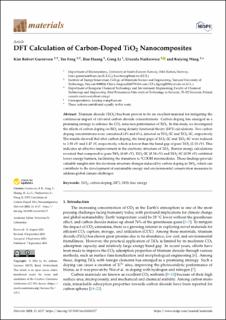DFT Calculation of Carbon-Doped TiO2 Nanocomposites
Peer reviewed, Journal article
Published version
Permanent lenke
https://hdl.handle.net/11250/3094336Utgivelsesdato
2023Metadata
Vis full innførselSamlinger
- Institutt for mikrosystemer [522]
- Publikasjoner fra CRIStin [3416]
Originalversjon
Gustavsen, K. R., Feng, T., Huang, H., Li, G., Narkiewicz, U. & Wang, K. (2023). DFT Calculation of Carbon-Doped TiO2 Nanocomposites. Materials, 16(18), Artikkel 6117. https://doi.org/10.3390/ma16186117Sammendrag
Titanium dioxide (TiO2) has been proven to be an excellent material for mitigating the continuous impact of elevated carbon dioxide concentrations. Carbon doping has emerged as a promising strategy to enhance the CO2 reduction performance of TiO2. In this study, we investigated the effects of carbon doping on TiO2 using density functional theory (DFT) calculations. Two carbon doping concentrations were considered (4% and 6%), denoted as TiO2-2C and TiO2-3C, respectively. The results showed that after carbon doping, the band gaps of TiO2-2C and TiO2-3C were reduced to 1.58 eV and 1.47 eV, respectively, which is lower than the band gap of pure TiO2 (2.13 eV). This indicates an effective improvement in the electronic structure of TiO2. Barrier energy calculations revealed that compared to pure TiO2 (0.65 eV), TiO2-2C (0.54 eV) and TiO2-3C (0.59 eV) exhibited lower energy barriers, facilitating the transition to *COOH intermediates. These findings provide valuable insights into the electronic structure changes induced by carbon doping in TiO2, which can contribute to the development of sustainable energy and environmental conservation measures to address global climate challenges.

